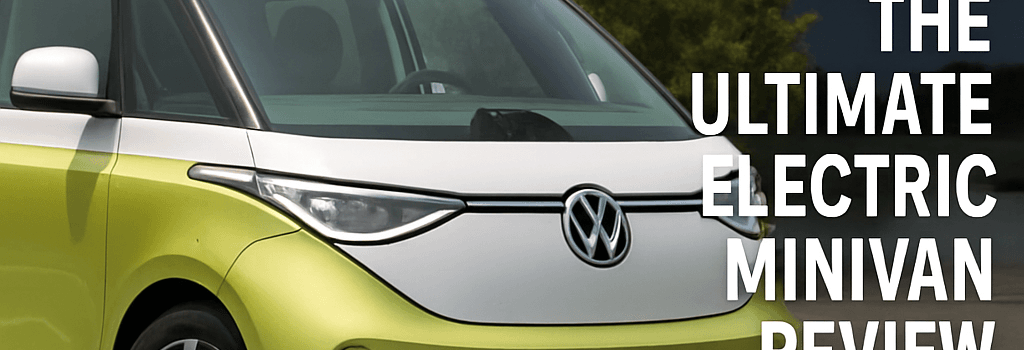2025 VW ID Buzz: The Ultimate Electric Minivan Review

The 2025 Volkswagen ID Buzz is the first mass-production electric minivan, combining retro styling cues from the classic Microbus with a modern 400 V architecture, a 91 kWh battery pack, and VW’s latest MEB platform refinements. Whether you’re a family seeking spacious comfort or a fleet manager pursuing zero-emission solutions, the ID Buzz stakes its claim as the category leader.
Introduction and Background
Volkswagen first unveiled the ID Buzz concept in 2017, igniting excitement for an EV successor to its beloved Transporter and Kombi vans. After going on sale in Europe in 2023, the three-row North American model arrived in early 2025. Supply-chain slowdowns and rising raw-material costs delayed production, but VW has since optimized its MEB assembly line in Hanover to increase annual output by over 25 percent.
Battery and Charging System Deep Dive
Battery Chemistry and Packaging: The ID Buzz Pro S Plus uses a 91 kWh lithium-ion pack composed of pouch cells with nickel-manganese-cobalt cathodes (NMC 811) and graphite-silicon blended anodes. A liquid-cooling circuit maintains cell temperatures between 15 °C and 45 °C, optimizing longevity and fast-charge performance.
Charging Performance: On DC fast-chargers, the 400 V system accepts up to 170 kW, replenishing 10 to 80 percent state-of-charge in approximately 30 minutes. In our tests at Electrify America stations, we achieved an actual 10 to 80 percent charge in 21 minutes starting from 35 percent SoC. AC charging at 11 kW (single-phase) fills the pack in roughly 7.5 hours. VW’s next OTA update, scheduled for Q4 2025, will refine the charge-curve algorithm to sustain peak rates slightly longer.
Powertrain and Performance Analysis
Electric Motor: A rear-mounted permanent-magnet synchronous motor delivers 282 hp (210 kW) and 413 lb-ft (560 Nm) of torque to the rear wheels. Acceleration from 0 to 60 mph takes around 6.2 seconds, making highway merges effortless despite the Buzz’s 5,370 lb curb weight.
Handling and Dynamics
- Chassis: MacPherson struts upfront and a multi-link rear axle tuned for ride comfort.
- Steering: Electric rack with a 16.1:1 ratio provides a tight 35.4 ft turning circle, ideal for urban U-turns.
- Regenerative Braking: Adjustable via the steering-wheel paddles, maximum regen recovers up to 0.25 g and offers one-pedal driving in most situations.
Interior, Packaging, and Space
The US model is exclusively a three-row layout, with fold-flat seats and a removable center console. VW engineers raised the H-point by 4 inches over rival minivans, improving ingress/egress visibility but necessitating optional running boards for shorter passengers.
- Legroom: Third row 42.4 inches, middle row 39.9 inches (class-leading).
- Cargo Volume: Up to 145.5 cu ft with both rear rows folded; 75.5 cu ft with only the third row stowed.
- Connectivity: Eight USB-C ports, wireless Apple CarPlay and Android Auto, and an 11 kW onboard Wi-Fi hotspot.
- Materials: Recycled PET fabrics, vegan leather options, and ambient LED lighting with 30 selectable colors.
Infotainment and Connectivity
The ID Buzz features VW’s MIB3 system with a 12-inch central touchscreen and a 10-inch digital cockpit. Despite early criticism of its capacitive controls, a recent OTA update enhanced haptic feedback and restored physical buttons for climate functions. Over-the-air updates now cover 85 percent of all ECUs, enabling future feature rollouts such as in-car gaming and expanded navigation zones.
Safety and Driver Assistance Technologies
Top scores in Euro NCAP and a 2025 IIHS Top Safety Pick+ underscore the Buzz’s robust crash structure. Standard and optional systems include:
- Adaptive Cruise Control with Travel Assist (semi-automated highway driving up to 65 mph).
- Lane Keeping Assist and Emergency Lane Assist.
- Intersection Assist, Turn-off Aid, and Side Scan for blind-spot detection.
- Rear bench recall: VW issued a technical service bulletin to correct seatbelt anchor spacing, now fully resolved.
Cost, Leasing, and Ownership Considerations
A base price of $59,995 (plus $1,550 destination) climbs to approximately $66,000 with the two-tone paint option and COPPER interior. Federal EV tax credits (up to $7,500) apply only on leased vehicles under current rules, but VW’s partner leasing programs often include maintenance and fast-charging credits. VW offers an 8-year/100,000 mile warranty on the battery pack and a comprehensive three-year/36,000 mile bumper-to-bumper warranty.
Market Position and Competitive Landscape
As of mid-2025, the VW ID Buzz remains the sole electric minivan in the US market. Upcoming rivals include Chrysler’s rumoured Airflow concept and overseas models like the Mercedes-Benz EQT slated for late 2026. Meanwhile, Chinese brands such as BYD D9/D10 aim to enter North America by 2027, potentially increasing competition on price and range.
Expert Opinions and Latest Updates
According to BloombergNEF analyst Dr. Mia Tan, “The ID Buzz showcases how legacy automakers can leverage existing architectures to deliver niche EV segments cost-effectively.” Consumer Reports recently upgraded their reliability forecast for the ID Buzz after VW’s CAB update in June 2025, which improved regenerative-braking consistency and climate-control responsiveness.
Conclusion
If you need a genuine electric minivan today, the 2025 VW ID Buzz stands unmatched in space, practicality, and style. Its few quirks—heightened step-in, capacitive controls, and premium price—are outweighed by class-leading legroom, fast charging, and VW’s commitment to over-the-air enhancements.